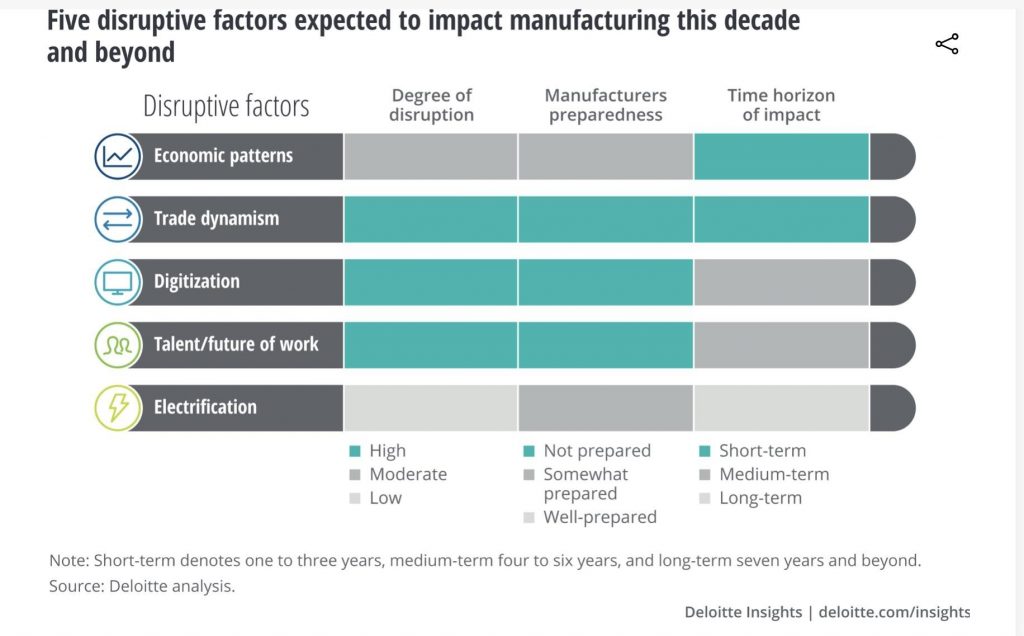The future of manufacturing and the forthcoming Fourth Industrial Revolution, also called Industry 4.0, have been accelerated at a pace no one could have predicted before the Covid-19 pandemic. Organizations have witnessed radical advances in both the technological and social spheres. The future of organizations in a digitalized manufacturing industry in the year 2030 will depend on how fast they evolve and embrace change.
Inexpensive data storage with increased computing power and Fourth Industrial Revolution technologies are transforming manufacturing at an  increasing rate. A Deloitte Insights report found that despite the fact that 90 percent of all data was created in recent years, many manufacturers have fallen behind in adopting broader digital transformation initiatives that span the entire enterprise.
increasing rate. A Deloitte Insights report found that despite the fact that 90 percent of all data was created in recent years, many manufacturers have fallen behind in adopting broader digital transformation initiatives that span the entire enterprise.
According to Deloitte, if manufacturers do not embrace digitization, as many as 35 percent of today’s industrial companies could be out of business or significantly changed within the next 10 years.
A C-level executive survey from North Carolina State’s Poole College of Management found competing against born digital firms as the top risk. Digital investments in the next few years will separate the winners from the losers.
New technologies are reshaping manufacturing with emerging trends of reshoring in global manufacturing production, there is anticipation that in 2021 totals to be even higher. Reshoring surged to record high in June 2021 with industries such as PPE, medical, tech, and defense among the industries experiencing the most activity. Estimates suggest that the U.S. manufacturing market is expected to reach a revenue value of over $14.1 billion by the year 2030.
The increasing adoption of Industry 4.0 technologies, including Artificial Intelligence (AI), Robotics, Automation, and the Industrial Internet of Things (IIoT) will continue to reshape the global manufacturing landscape. Going forward, traditional manufacturing will see a structural transformation, growth, and job creation. Despite automation taking a front seat in manufacturing, the supply chain, and logistics, the novel jobs of the future are ones that do not exist today.
Navigating disruption in manufacturing
The rapidly evolving manufacturing landscape has witnessed trending disruptors during and post-Covid-19. These disruptors are the new normal. For manufacturing leaders this has brought an operating landscape that combines the old with the new.
Old long-standing patterns and new factors which are disrupting the industry co-live and collaborate in harmony. Manufacturing leaders must remember that not evolving, not embracing change means to be out of business.
Disruptive factors expected to impact manufacturing toward 2030

Image Source: Deloitte Insights
Deloitte has identified five disruptive factors that are expected to have an impact on manufacturers in the next few years and toward 2030. All five factors below have the potential to redefine how manufacturing will possibly look by 2030.
Economic patterns
- Trade dynamism
- Digitization
- Talent/Future of work
- Electrification
The future of manufacturing Is in the Cloud
Sustainability. Evolution. Resilience. Change. These are words we recognize as connected to global manufacturing and the supply chain. They are the four pillars that keep the manufacturing businesses relevant and agile.
When the Covid-19 pandemic suddenly hit the world, it brought a good quota of unexpected instability and disruption which were undoubtedly hard-felt within the manufacturing world.
The lasting effects of the pandemic on businesses and more specifically in the manufacturing industry and the supply chain brought new levels of adaptation, challenges, and rapid adoption of changes which had already been ongoing but at a more sluggish pace.
The resilience of manufacturing: Moving to the Cloud and a little history of Cloud computing
In response to the Covid-19 crisis, manufacturing leaders around the world have invested in, adopted, or escalated their cloud computing technology. Cloud computing offers agility, low cost, better global access to resources, and real-time collaboration.
Despite the belief that Cloud computing belongs to the Millennial generation — and many of them believe it so — the first roots of non-local computing is easily traced back to the early 1950s.
In 1950, a military mainframe was developed to connect computer terminals across an internal matrix. When it hit the scientific community, the non-local storage technology rapidly advanced.
In 1996, the term ‘Cloud computing’ itself was coined within a Compaq internal document, and this was the earliest mention of Cloud computing in literature. Originally, in the early 1990s, the term ‘Cloud’ was linked to the concept of distributed computing, which went mainstream at Apple-spawned General Magic. And in 1999, Salesforce became the first company to offer applications over the Internet, and Software as a Service (SaaS) was born.
In the future, Cloud technology will continue to evolve way beyond its current status bringing a plethora of benefits on how to access data and information, collaboration, and novel benefits that will emerge as the technology evolves. Manufacturing leaders looking to optimize their performance while maintaining their resilience toward 2030, will find a good ally in the Cloud. Finally, digitization of core processes and operations is an option worth considering.
##
Editor: To experience the increased productivity and collaboration of bringing your business onto a single cloud-based platform Click here